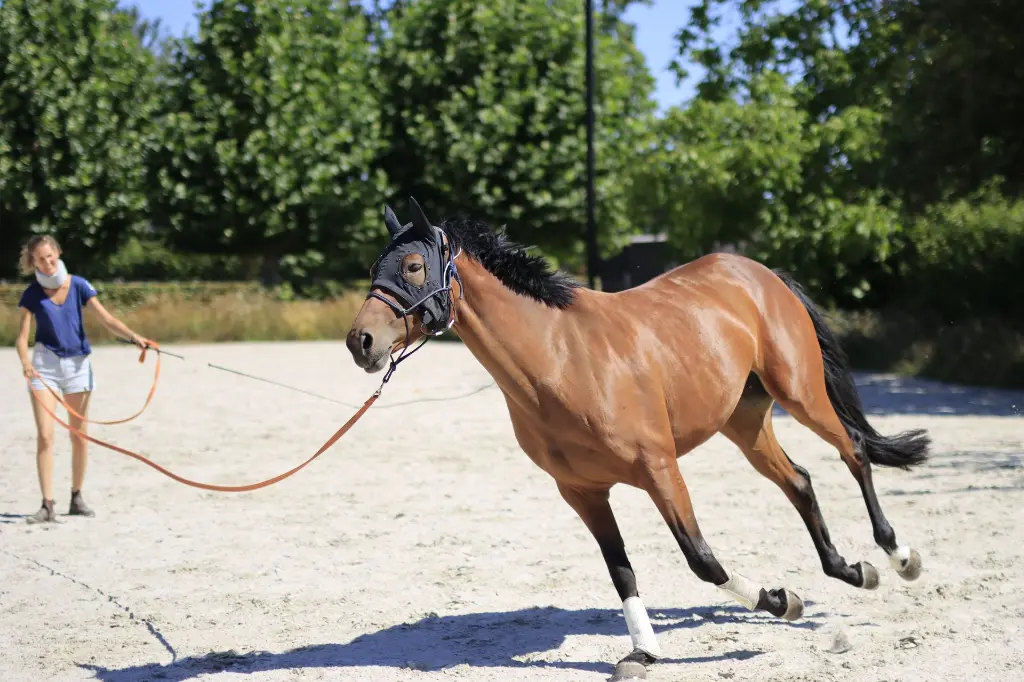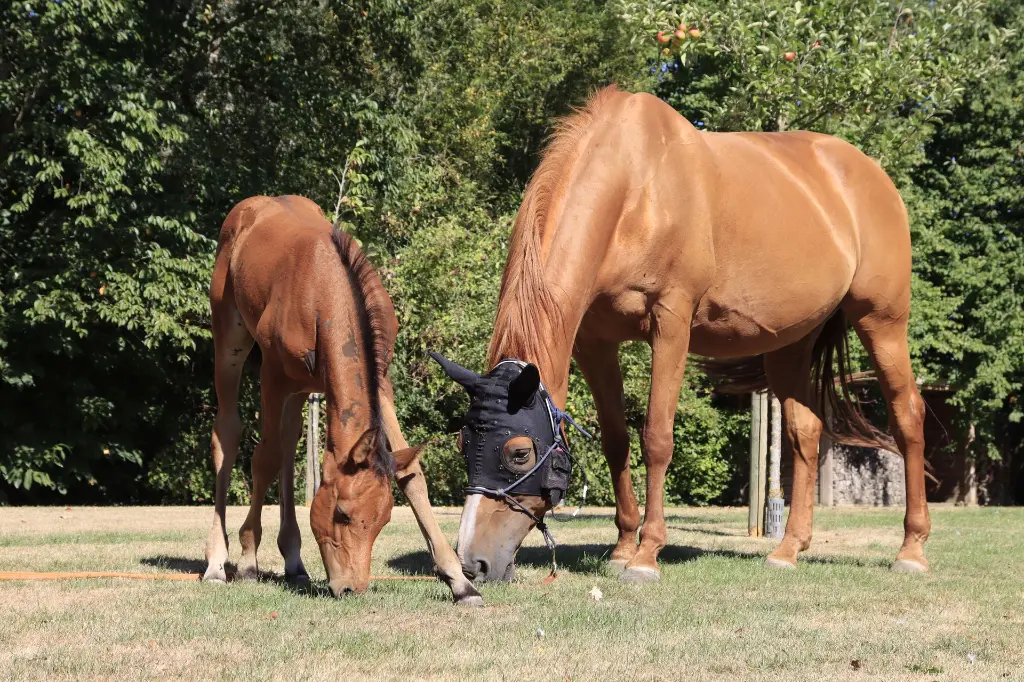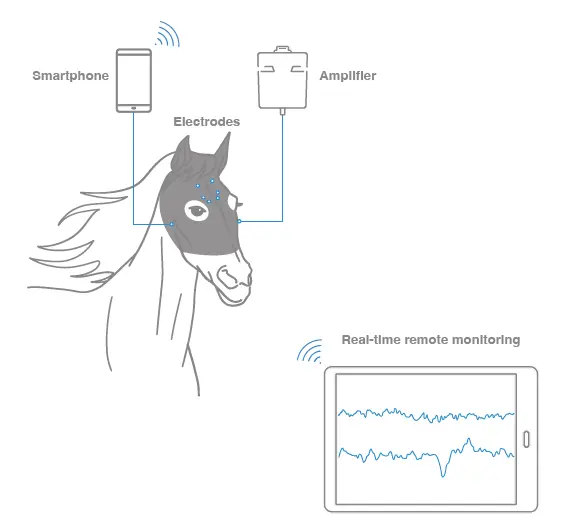Mammal.tech uses mobile EEG to monitor stress and brain activity in sport horses, adapting tech from human athletes. This helps detect issues early and improve performance and well-being. The system provides reports with key metrics and care recommendations. It may also be used for other animals in the future.
From humans to animals
Mammal.tech is a company that aims to translate and apply the knowledge gathered by its funders on EEG dynamics in top-level human athletes to the animal domain, with a specific focus on high-performing horses.
EEG is a powerful tool to study brain functions in all kinds of environmental conditions, including during physical activity. Thanks to its flexibility and portability, EEG has been particularly useful in the study of human athletes, providing useful information on how the brain contributes to top performance in various sports [6]. However, the knowledge gathered from EEG research on human athletes can also be applied to high-performing horses, potentially providing valuable insights into how to maximize their performance and overall well-being.
A mobile EEG system can provide numerous benefits for monitoring the well-being of animals, by providing markers to track and quantify an animal’s cognitive and emotional state. By exploiting a custom-made mobile EEG system, mammal.tech seeks to easily and quickly monitor the brain activity of horses in a variety of settings, including during everyday activities at the stables, during transportation and before and after a race.
Racehorses, more than other animals, are confronted with internal and external stress factors related to competitions and are often exposed to unfamiliar and unfriendly environments. Monitoring their stress levels during transportation, for example, can be crucial. The transportation of horses can be a stressful experience for the animals and can potentially affect their performance. By using EEG markers, trainers and veterinarians can identify any changes in the animal’s stress levels and take appropriate action to address any issues.
Mammal.tech aims to address this problem with an easy-to-use device which allows for a direct collection of brain activity data before, during and after exercise, just like in human high performers. Thanks to a streamlined analysis pipeline, these data can then be used to generate concise individual reports to highlight stress levels, fatigue, sleep quality and other parameters essential for the animal’s well-being and performance. Along with this report, appropriate recommendations and treatment options are provided to the animal’s carer to facilitate their decision-making.

Figure 1: The EEG system allows for the monitoring of brain waves during exercise...

Figure 2: ...and during social interactions, to evaluate the health and mental well-being of the horse.
The solution
The system, developed by ANT Neuro in partnership with mammal.tech, consists of a cap which is easily placed on the horse’s head in less than two minutes. The cap is equipped with a specifically designed grid of 24 sponge electrodes (based on ANT Neuro’s waveguardTM net technology) which allows for the recording of the horses’ brain activity at the surface of the skin, in an absolutely non-invasive and comfortable way. Two pouches on the sides of the cap contain a small, portable, eegoTM24 amplifier and a smartphone to receive the signal collected by the electrodes. The brain data are then transmitted via WiFi to a tablet, for the operator to monitor them remotely, in real-time. The whole system is wireless, portable and works on battery, allowing for the horse to carry on its routine daily activities without constraints.

Figure 3: Schematic of the EEG system: the smartphone embedded into the cap transmit the brain data to a tablet via WiFi, enabling a real-time remote monitoring.

Figure 4: A grid of 24 sponge-based electrodes is built inside the cap.

Figure 5: A small portable amplifier is tucked on the side of the cap
Future outlook
The development of a specifically designed mobile EEG system can provide numerous benefits for high-performing racehorses, their trainers and veterinarians. By allowing for the easy and non-invasive monitoring of brain activity, this technology can improve the understanding of how cognitive and emotional states affect the performance of these animals and inform the carers on the best actions to take in order to ensure their overall health and well-being. The system is currently being used to collect brain data from horses during the performance of different activities to identify the most informative EEG markers to assess the animal’s mental status.
In the future, this technology has the potential to expand to different applications and benefit several other animals: from monitoring the health and wellbeing of cattle in dairy farms, to assisting the training of service, search and rescue and police dogs.
Meet the mammal.tech team

Guy Cheron
a neurophysiologist and full professor in the Department of Psychology and Educational Sciences at the Université libre de Bruxelles (ULB). Cheron’s research focuses on the neurophysiology of motor control, with a particular interest in the role of the cerebellum in motor learning and coordination. He has published numerous articles in leading scientific journals and has received several awards and grants for his work. Over his scientific career Cheron has also worked in the field of brain-computer interfaces, being a PI for the Mindwalker project, which resulted in the development of the first European walking exoskeleton piloted by brain signals [1]. He was also actively involved in several neuroscience space experiences realized on board of the International Space Station (NeuroCog, NeuroSpat, and Adriadna ESA missions) where his group used EEG dynamics to develop new sensorimotor paradigms (virtual reality) and show the alteration of top-down signals in visual perception in a weightlessness environment [2,3,4]. He also investigated the role of cerebral oscillations linked to the psychological flow in the top performance [5,6].

Mathieu Petieau
a scientific collaborator at the Laboratory of Neurophysiology and Movement Biomechanics at the Université libre de Bruxelles (ULB). His research area includes the study of EEG rhythms on earth and in microgravity, prostheses and exoskeletons controlled with brain signals (BCI), EEG synchronized VR protocols, dynamics of sensorimotor coordination through dynamic recurrent neural networks and accurate detection/analysis of eye movements. Since 2006, he’s been working on different projects in collaboration with the European, American, Russian and Japanese space agencies [2,3,4]. As of 2015, he left the public domain and became CTO in the spin-off Human Waves, specialized in clinical tests using EEG signals. Since 2018, he focused his research in the field of sports neuroscience, working with elite athletes to better understand the neural correlates of high performances [6]. He is currently highly involved in several R&D projects leveraging cutting edge technologies, such as mammal.tech.

Marc Bogaerts
International Public Relations

Carole T’Jollyn
Head of Horse Training and Protocols

Paul Meyers
Chief Innovation and Chief Information Officer

Frank Zanow
Head of Technology
References
[1] J. Gancet, M. Ilzkovitz,G. Cheron, Y. Ivanenko,F. Zanow. “MINDWALKER: A brain controlled lower limbs exoskeleton for rehabilitation. Potential applications to space.” in11th Symposium on advanced space technologies in robotics and automation, 2011
[2] G. Cheron, A. Leroy,C. De Saedeleer, et al. “Effect of gravity on human spontaneous 10-Hz electroencephalographic oscillations during the arrest reaction.” Brain Research, 2006
[3] A.M. Cebolla, M. Petieau,B. Dan, L. Balazs,J. McIntyre, G. Cheron. “Cerebellar contribution to visuo-attentional alpha rhythm: insights from weightlessness.” Scientific Reports, 2016
[4] G. Petit, A.M. Cebolla,S. Fattinger, M. Petieau,L. Summerer, G. Cheron et al. “Local sleep-like events during wakefulness and their relationship to decreased alertness in astronauts on ISS.” Npj Microgravity, 2019
[5] G. Cheron. “How to Measure the Psychological “Flow”? A Neuroscience Perspective.” Frontiers in Psychology, 2016
[6] G. Cheron, G. Petit,J. Cheron, A. Leroy, et al. “Brain Oscillations in Sport: Toward EEG Biomarkers of Performance.” Frontiers in Psychology, 2016